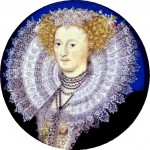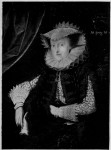- Attributed to Hans Eworth
- Mary Sidney circa 1590
- Mary Sidney 1614
Mary Sidney Herbert, Countess of Pembroke (1561-1621) was born in 1561 in Worcestershire, England, to Sir Henry Sidney and Lady Mary Dudley Sidney. Sir Henry Sidney served as Lord President of the Council in the Marches of Wales from 1559 to 1586, and then as Lord Deputy of Ireland from 1565 to 1571, and 1575 to 1578. Both the Sidney family and the Dudley family’s fortunes were dependent on the favor of the monarch. Lady Sidney served Queen Elizabeth for some time, which helped establish family favor and a good social position for Mary Sidney.
Mary Sidney had three brothers: Philip, Robert, and Thomas, and three sisters: Margaret, Elizabeth, and Ambrosia. She and her sisters received an excellent education: they learned scripture, classics, rhetoric, and a multitude of languages, including French, Italian, Latin, and possibly even Greek and Hebrew. They were also schooled in household medicine and administration, music, voice, lute, and needlework.
In 1575, Queen Elizabeth invited Sidney to court. In 1577, she became the third wife of Henry Herbert, second Earl of Pembroke, becoming Countess of Pembroke at age 15. The pair had four children: William in 1580, Katherine in 1581, Anne in 1583, and Philip in 1584. After the deaths of her daughter Katherine, her father, mother, and brother Philip, all within two years, Sidney retreated to the Pembroke estates in Wiltshire for a period of mourning.
She returned to London in 1588, reentered public life, and began her career as a writer. Her early works included translations of essays written in Philip’s praise, completion of other writings by Philip, and the supervision of the publication of The Countess of Pembroke’s Arcadia (a text originally written by Philip for her). She also translated Petrarch’s Triumph of Death, and wrote at least three original poems: A Dialogue between Two Shepherds, Thenot and Piers, in Praise of Astrea; To the Angell Spirit of Sir Philip Sidney; and Even Now that Care to Queen Elizabeth; perhaps also The Dolefull Lay of Clorinda.
Sidney modeled her writing after her brother’s, as well as Edmund Spenser. She wrote in styles “appropriate” for women of the time (elegy, encomium, and translation), to maintain traditional status while subtly transgressing the literary boundaries considered appropriate for women. Sidney never apologized for her writing, nor did she find it necessary to consistently reaffirm her gender.
Several of Sidney’s works were published during her lifetime. Two were English translations: A Discourse of Life and Death by Philippe de Mornay (originally in French), and A Tragedy by Robert Garnier (also originally in French). Both posited the importance of reason over emotion and public duty over private life, and were published in 1592. In 1595, “The Doleful Lay of Clorinda” was published in Edmund Spenser’s literary journal Astrophel. In 1602, “A Dialogue between Two Shepherds, Thenot and Piers, in Praise of Astrea,” was published in Francis Davison’s collection A Poetical Rhapsody.
Sidney also completed the translation from the Hebrew of the 150 Psalms, which her brother Philip had begun before his untimely death. Philip Sidney composed metrical versions of Psalms 1–43; Mary Sidney completed the 150 Psalms. These translations into English verse have been praised for their word play, metrical complexity, use of rhetoric, use of metaphor, and scholarly and linguistic prowess. They were circulated widely at the time and recognized as her greatest literary achievement. [1]Her Psalms were influential to later devotional poetry by George Herbert, Aemilia Lanyer, and John Donne. Donne himself said “We thy Sydnean Psalms shall celebrate.” A copy of the Psalms was presented to Queen Elizabeth I in 1599.
Sidney’s husband died in 1601, and she spent her years as a widow arranging marriages and positions at court for her children. She was celebrated as a writer during her lifetime, and is said to be the first English woman recognized as a poet. She died of smallpox on 25 September 1621 in London and is buried alongside her husband in Salisbury Cathedral.
[1] Hannay, ‘Herbert [née Sidney], Mary, countess of Pembroke (1561–1621)’, ODNB.
Sources:
Margaret Hannay, “Mary Sydney, Countess of Pembroke.” Mary Hays, Female Biography; or, Memoirs of Illustrious and Celebrated Women, of All Ages and Countries (1803). Chawton House Library Series: Women’s Memoirs, ed. Gina Luria Walker, Memoirs of Women Writers Part II (Pickering & Chatto: London, 2013), vol. X, pp.
Margaret P. Hannay, “Mary Sidney Herbert, Countess of Pembroke.” The Sidney Homepage. 2000. Accessed July 12, 2013. http://www.english.cam.ac.uk/sidney/pembroke_biography.htm
Margaret P Hannay, Philip’s Phoenix: Mary Sidney, Countess of Pembroke (New York: Oxford University Press, 1990 ).
Mary Hays, Female Biography, or Memoirs of illustrious and celebrated women of all ages and countries (6 volumes) (London: R. Phillips, 1803).
Anniina Jokinen, “Mary (Sidney) Herbert.” Luminarium: Encyclopedia Project. 28 February 1998. Accessed July 21, 2013. http://www.luminarium.org/renlit/marybio.htm
Frances B. Young, Mary Sidney, Countess of Pembroke (London: David Nutt, 1912).
Resources:
Brooklyn Museum
Elizabeth A. Sackler Center for Feminist Art: The Dinner Party: Heritage Floor: Mary Sidney
https://www.brooklynmuseum.org/eascfa/dinner_party/heritage_floor/mary_sidney.php



